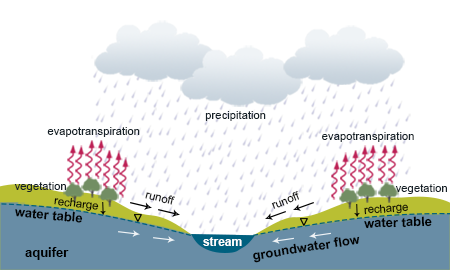
Welcome!
DWEE has developed three computer simulations to illustrate the interaction of surface water and groundwater. To begin, explore how changing the elevation of the water tableThe water table is the upper level of the underground area in which the soil and rocks are saturated with water. affects this interaction.
Water Table
The purpose of this simulation is to illustrate the interaction between surface water and groundwater, focusing on how the relative position of the water table and stream levels affects the direction of flow and rate of interaction between the stream and the aquiferAn aquifer is the area saturated with water beneath the water table. (i.e., whether a stream is a gainingA stream is gaining in reaches where water flows from the aquifer towards the stream. or losing streamA stream is losing in reaches where water flows from a stream towards the aquifer.).




